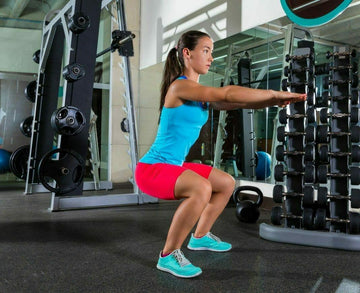Squats are one of the basic exercises in many training programs and are particularly effective for promoting strength, stamina and flexibility. They not only train the entire lower body, but also strengthen the core and improve posture. Whether in the gym, at CrossFit or at home: squats are the perfect all-round exercise to challenge the entire body and stay fit.
Squats: Training for the whole body
Squats are a functional exercise that activates more than 200 muscles simultaneously. The muscles in the lower body - thighs, calves and buttocks - are particularly intensively used. At the same time, the exercise improves mobility in the knees , hips and ankles , which can reduce the risk of injury in these joints.
However, squats are not just a must for athletes. They train movement patterns that are constantly required in everyday life, such as lifting heavy objects, getting up from a chair or bending over. Those who regularly incorporate squats into their training not only improve their fitness, but also their performance in everyday life.
Benefits of Squats for Everyday Life
The squat in the gym corresponds to the squat that we do in everyday life - whether it's lifting boxes, bending over or emptying the washing machine. By doing squats regularly, you improve the strength and stability in the movements you perform every day. In addition, good squat technique helps you improve your posture , which leads to a healthier lifestyle in the long term.
Which muscles are trained during squats?
Squats are one of the most effective full-body exercises. The main muscle groups they target are:
• Quadriceps (thigh muscles) : The largest muscle in the thigh extends the knee joint.
• Gluteus maximus : This muscle extends the hips and shapes the buttocks.
• Calf muscles (musculus triceps surae) : Supports the ankle and stabilizes the foot.
• Hip adductors and abductors : Pull the thighs towards the center or outwards.
• Back extensors and core : Stabilize the upper body during the exercise and keep the spine in a neutral position.
Throughout the movement, the abdominal and back muscles also work to maintain a stable posture, making squats a comprehensive exercise that builds both strength and stability.
Squats vs. Squats: Is There a Difference?
The term squat in English means nothing other than the knee bend. The English term is often used in modern fitness programs, but the principle remains the same. Whether you call it a knee bend or a squat, the exercise is an essential part of strength training and is still a key component for improving strength and flexibility.
How to do squats correctly: The standard technique
Proper form is crucial to using the squat's full potential and avoiding injury. Here's how to do a standard squat correctly:
1st Starting position : Stand upright with your feet shoulder-width apart. Your toes point slightly outwards.
2nd Flexion : Bend your hips and knees simultaneously while lowering your buttocks backwards and downwards. Stretch your arms straight out in front of you to maintain balance.
3. Depth : Lower yourself until your thighs are at least parallel to the floor. If possible, go deeper to promote flexibility.
4th Posture : Keep your back straight and your head in line with your spine. Make sure your knees do not extend beyond your toes and do not fall inward.
5th Standing up : Push yourself back up from your heels to the starting position. Your knees should point slightly outwards during the upward movement, in the same direction as your feet.
How deep should you go when doing squats?
The depth of the squat depends on your flexibility and fitness level. In general, the deeper the squat, the more intense the workout. A full squat where the thighs go below parallel (also called an ass-to-grass squat ) has the greatest training effect. However, beginners can start with a shallower squat and gradually increase the depth.
How many squats should you do?
The ideal number of repetitions depends on your individual fitness level. For beginners, we recommend 3 sets of 10 to 20 repetitions . You can take a break of 30 to 60 seconds between sets. Advanced users can increase the intensity by adding weights or increasing the number of repetitions.
Squats and knee problems: is it possible?
Squats have a bad reputation when it comes to knee problems. But if done correctly, squats are not harmful to the joints . On the contrary: they strengthen the muscles around the knee and can even help prevent knee problems if done regularly. However, it is important that you perform the exercise cleanly and in a controlled manner.
If you already have knee problems, you should consult a doctor or physiotherapist before training. If you have existing problems with your kneecap, you should avoid deep squats and work with a smaller range of motion to begin with.
Variations of squats: Bring more variety to your training
Squats offer numerous variations that make them adaptable to every fitness level. Here are some popular variations:
• Goblet Squat : Hold a weight in front of your chest to additionally challenge your core muscles.
• Sumo Squat : Stand with your feet wider than shoulder width apart and turn your feet outwards to target your inner thighs more.
• Pistol Squat (single-legged squat) : An advanced variation where you perform the squat on one leg while the other leg remains straight.
• Bulgarian Split Squat : One foot is placed on a bench while you perform a squat on the other leg. This variation specifically trains balance and stability.
Conclusion: Squats – indispensable for strength and mobility
Squats are one of the most versatile and effective exercises you can incorporate into your training. They promote strength, flexibility and stability - both in training and in everyday life. Make sure you perform the exercise with clean technique and gradually increase your flexibility. Whether you're a beginner or advanced: squats should be part of every training plan!
By doing squats regularly, you not only strengthen your body but also improve your quality of life.
FAQ on squats: How to do them correctly and frequently asked questions
How do I do squats correctly?
The correct execution begins with a shoulder-width-width stance. Lower your buttocks by bending your hips and knees at the same time, and keep your back straight. Make sure that your knees do not extend beyond your toes and turn outwards. Go as low as your flexibility allows and push yourself back up from your heels.
Which muscles are trained during squats?
Squats primarily train the thigh muscles (quadriceps) , the glutes and the calves . Additionally, the core and back muscles are activated to ensure stability during the movement.
How deep should I squat?
The deeper you go into the squat, the more intense the workout becomes. It is optimal if your thighs are at least parallel to the floor. Advanced squatters can aim for the ass-to-grass depth, where the hips are below the knees.
How many squats should I do?
For beginners, 3 sets of 10-20 reps is a good start. Depending on your fitness level, you can increase the number of reps or add weight. Make sure to rest for 30-60 seconds between sets.
Can I do squats if I have knee pain?
When done correctly, squats can even help prevent knee problems because they strengthen the surrounding muscles. However, if you already have knee problems, you should consult a doctor or physiotherapist before exercising.
What is the difference between squats and knee bends?
There is no difference - the term squat is simply the English term for knee bend. Both refer to the same exercise that is used in many fitness programs.
Can I do squats with weights?
Yes, squats can be performed with weights such as barbells, dumbbells or kettlebells to increase the training effect. Make sure to keep the technique clean even with additional weights.
How do I prevent my knees from tipping inward?
Make sure to rotate your knees outward throughout the movement, in the same direction as your feet. This technique protects your knee joints and ensures correct execution.
How often should I include squats in my workout?
Squats can be incorporated into your training plan 2-3 times a week, depending on the intensity. Give your muscles enough time to regenerate and make sure to vary the exercises by doing different variations.
What variations of squats are there?
There are many variations to make the exercise more challenging, such as goblet squats (with weight in front of the chest), sumo squats (wider stance) or one-legged squats (pistol squats), which require additional balance and stability.





